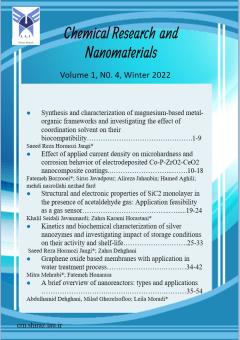Synthesis and characterization of magnesium-based metal-organic frameworks and investigating the effect of coordination solvent on their biocompatibility
Subject Areas : Synthesis and Characterization of Nanostructures
1 - Hormozi laboratory of Chemistry and Biochemistry, Zabol, Iran
Keywords: Biocompatibility, Coordination solvent, Metal-organic framework,
Abstract :
In this contribution, magnesium-based metal-organic frameworks (average size, 430 nm) were synthesized by a simple, low-cost, and high-efficient method utilizing different coordination solvents. The as-synthesized frameworks were then characterized by several characterization methods. The formation of metal-organic framework(MOF( coordination bindings was confirmed by FT-IR, EDX, UV-Vis, and SEM analyses. The organic content of the as-prepared MOFs was quantified by elemental analysis. The results showed that the coordination yield in protic solvents is higher than that of the aprotic solvents. In contrast, the organic content of the MOFs prepared in aprotic media was found to be more than that of the protic solvent due to the competitive role of aprotic solvents in the coordination process. The effect of coordination solvent on the biocompatibility of as-synthesized MOFs was also investigated using the standard protein absorption-desorption and hemolysis analysis. The protein adsorption results showed that the as-synthesized MOFs with protic solvents absorbed about 0.02 μg μg-1, which is 17.5-fold lower than that of the aprotic solvents. The hemolysis ratio of the synthesized sample in protic solvent was calculated at about 0.3%, which is 5 times lower than the hemolysis ratio of the synthetic sample in aprotic media, indicating their high erythrocyte compatibility. These findings reveal that the biocompatibility of magnesium-based metal-organic frameworks is significantly affected by the coordination solvent. The Authors strongly recommend using the results of this contribution for the synthesis of biocompatible carriers for drug and enzyme immobilization aims.
1. J.S. Qin, S. Yuan, L. Zhang, B. Li, D. Y. Du, N. Huang, W. Guan, H. F. Drake, J. Pang, Y. Q. Lan, A. Alsalme, J. Am. Chem. Soc. 14, 2054 (2019).
2. J. D. Sosa, T. F. Bennett, K. J. Nelms, B. M. Liu, R. C. Tovar, Y. Liu, Crystals 8, 325 (2018).
3. N. Stock, S. Biswas, Chem. Rev. 112, 933 (2012).
4. S. Zhang, Q. Yang, X. Liu, X. Qu, Q. Wei, G. Xie, S. Chen, S. Gao, Coord. Chem. Rev. 307, 292 (2016).
5. A. Rabenau, Angew. Chem., Int. Ed. Engl. 24, 1026 (1985).
6. K. Byrappa, M. Yoshimura, Noyes Publications: New York, 2002.
7. L. Esrafili, A. Azhdari Tehrani, A. Morsali, L. Carlucci, D. M. Proserpio, Inorganica Chim. Acta 484, 386 (2019).
8. J.W. Maina, C.P. Gonzalo, A. Merenda, L. Kong, J.A. Schütz, L.F. Dumée, Appl. Surf. Sci. 427, 401 (2018).
9. L. Li, S. Shen, J. Su, W. Ai, Y. Bai, H. Liu, Anal. Bioanal. Chem., 1 (2019).
10. Z.Y. Yao, J.H. Guo, P. Wang, Y. Liu, F. Guo, W.Y. Sun, Mater. Lett. 223, 174 (2018).
11. A. Ansari, V.U. Siddiqui, I. Khan, M.K. Akram, W. Ahmad, A. Khan Siddiqi, Metal-Organic-Frameworks (MOFs) for industrial wastewater treatment, 2nd edn, (Metal-Organic Framework Composites, 2019), pp. 1-28.
12. Y. Liu, A. J. Howarth, N. A. Vermeulen, S. Y. Moon, J. T. Hupp, O. K. Farha, Coord. Chem. Rev. 346, 101 (2017).
13. N. Ahmad, H.A. Younus, Z. Gaoke, K.V. Hecke, F. Verpoort, Adv. Mater. 31, 1801399 (2019).
14. Y. Hu, L. Dai, D. Liua, W. Dua, Y Wang, Renewable Sustainable Energy Rev. 91, 793 (2018).
15. S.S. Nadar, V.K. Rathod, Int. J. Biol. Macromol. 152, 1098 (2020).
16. S.R. Hormozi Jangi, M. Akhond, Process Biochem. 105, 79 (2021).
17. S.R. Hormozi Jangi, M. Akhond, Microchem. J. 158, 105328 (2020).
18. S.R. Hormozi Jangi, M. Akhond, J. Chem. Sci. 132, 110 (2020).
19. D.S.H. Chan, M. E. Kavanagh, K.J. McLean, A.W. Munro, D. Matak-Vinković, A.G. Coyne, C. Abell. Anal. Chem. 89, 18, 9976 (2017).
20. M. Jackson, H.H. Mantsch. Biochimica et Biophysica Acta 1078, 231 (1991).


